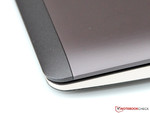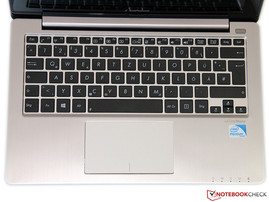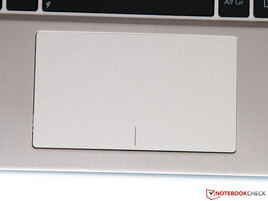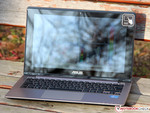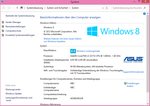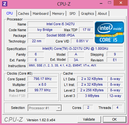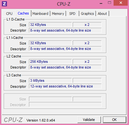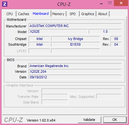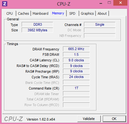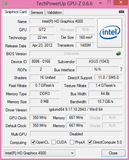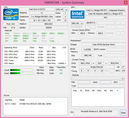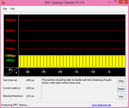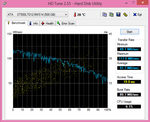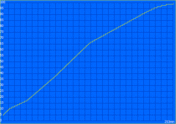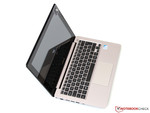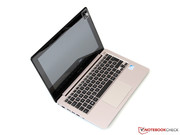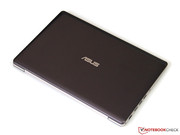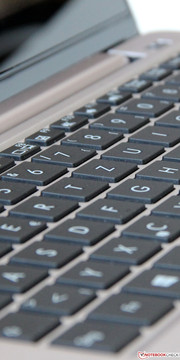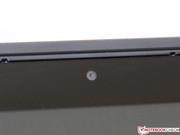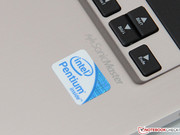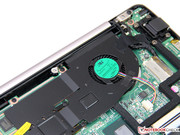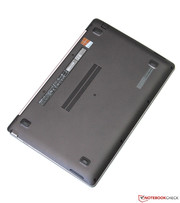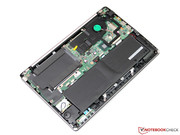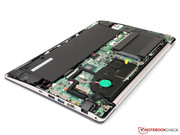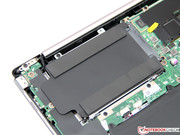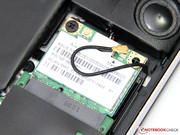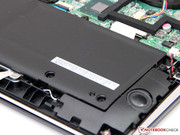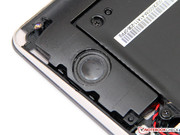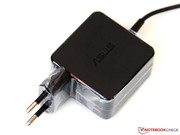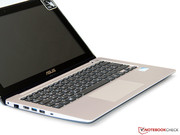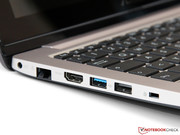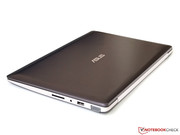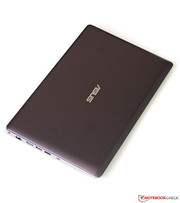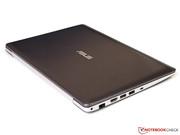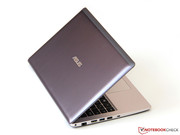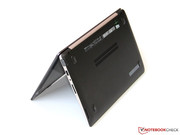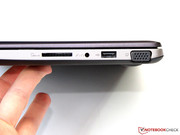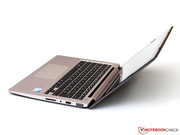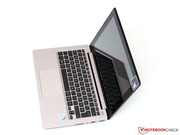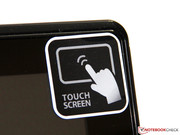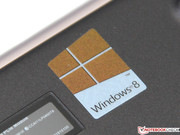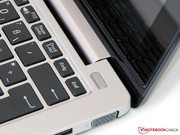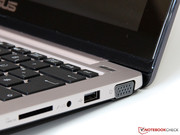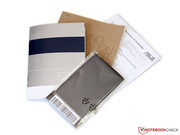Review Asus VivoBook S200E Subnotebook

For the original German review, see here.
Are typical subnotebooks a thing of the past? More and more buyers flock to tablets and Ultrabooks. Asus shows courage to innovate in an attempt to stop the exodus and introduces the VivoBook S200E.
The concept seems simple: use a touchscreen and combine it with Windows 8 so the VivoBook can be used like a tablet, while preserving the advantages of a full-fledged notebook. Dell follows a similar strategy with their XPS 12 though it is clearly in a different league as far as the price point is concerned (over 1000 Euros / ~$1300)
The S200E-CT182H, which starts at 550 Euros (~$710), features hardware which is significantly less powerful: Core i3-3217U, 4 GB RAM, and a 500 GB hard drive. The 11.6-inch WXGA display also reflects the entry-level status of the notebook. Asus offers an even less expensive version with Pentium ULV processor and/or less storage space.
Case
Impressive: unlike other notebooks in this price range, the chassis of the VivoBook S200E is not made from simple plastic, but to a large extent from high quality, brushed aluminum. The metal is not only used for the back of the display lid, but also the top of the base unit. That particular piece is milled from solid aluminum - similar to the (much more expensive) Zenbook series. Only the bottom cover is made from plastic.
The net result is that the entire notebook is remarkably rigid and resilient. The VivoBook weighs in at 1.4 kilograms (3.09 pounds), is only 2.2 centimeters (0.87 inch) thick, torsionally extremely rigid and resists pressure well - some Ultrabooks don't score nearly as well. The build quality is also very high: the transition between the different sections is without flaws, the corners are nicely rounded, and the gaps are even and unobtrusive.
The construction of the display reveals a drawback: the lid can't be folded down onto the keyboard (like with convertibles). The not overly precise (but stiff enough) hinges allow the display to be tilted back to about 140 degrees, which means that the S200E is not a full-fledged tablet replacement. We also don't like the display bezel, which is very wide (20-23 millimeters / 0.79-0.91 inches) and increases the size of the unit - it looks like a 12-inch panel could fit.
Connectivity
No surprises here: the VivoBook features the usual selection of ports for notebooks in this price segment. Asus integrated three USB ports - one supporting the new 3.0 standard. There's also a card reader (SD/SDHC/MMC), display ports (VGA and HDMI), and other standard ports (headphone jack, LAN, Kensington Lock). We would have appreciated a DisplayPort to allow the user to connect high-resolution external monitors.
Most of the ports are easily accessible on the left side of the chassis. The distance between them is large enough to prevent larger devices from blocking other ports when plugged in.
Communication
Since neither Bluetooth nor WWAN are offered, WLAN and LAN remain the only options as far as connections to the outside world are concerned. The latter uses a controller from Qualcomm/Atheros, which only supports the slower Fast Ethernet standard and thus connects at only 100 MBit/s.
The WLAN adapter (which is sourced from the same manufacturer) is also an entry-level model. The AR9485 only supports the (often crowded) 2.4 GHz band and IEEE 802.11b/g/n. Even though the data transfer rate is only 150 MBit/s (1x1 Single Stream), we had no issues with the stability of the connection or with the range.
The VivoBook features a 0.9 megapixel webcam (1280x720 pixels), which is hidden under the layer of glass in the bezel of the display. The picture quality is decent, the graininess acceptable, and the sound quality adequate.
Accessories
Aside from the diminutive power adapter with 33 Watts, a few pamphlets, and a cleaning cloth, there are no additional items in the box.
The OS (64-bit Windows 8) presents itself cleanly: in addition to various tools, one of which is supposed to make driver updates easier, Asus included useful extras like Adobe's PDF reader and McAfee Internet security (although only a trial version with activation pop-up messages).
Maintenance
The underside of the notebook features a total of nine screws, which hold the bottom plate in place. After the removal of said screws, the cover can be removed with a little bit of force. This action demands a bit of skill to avoid breaking off the small plastic tabs.
Expandability is fairly limited in any case: the RAM is soldered onto the motherboard so the system is limited to 4 GB. At least the 2.5-inch hard drive is easy to replace, although it should be noted that a low-profile model (7 millimeter) is required. Those wanting to swap out the WLAN module for a faster one need to consider that only one antenna is integrated.
Warranty
Like most inexpensive notebooks, the VivoBook S200E is only covered for 12 months. At least Asus offers fairly inexpensive extensions, which we would highly recommend. Different online retailers offer warranty extensions to 24 months (pick up and return service) starting at 28 Euros (~$36).
Input Devices
Keyboard
The black chiclet-style keyboard is seamlessly integrated into the aluminum chassis, which in turn adds to the impression of high quality. The aluminum keyboard area is also responsible for exceptionally high rigidity - even when firm pressure is applied to the 15 x 15 millimeter (0.59 x 0.59 inch) keys, no real flex is noticeable. With the exception of the arrow keys, which are a bit undersized, the layout is pretty standard and doesn't take a long time to get used to.
Although the click point could be slightly better defined and the key travel longer, we are very happy with the very good feedback and the typing experience overall. The VivoBook does not suffer from the usual issues that plague low-priced notebooks: the keys don’t clickety-clack in the least and don't tilt - even when not hit perfectly in the center. Most users will be quite happy with the integrated keyboard and shouldn't require an external one.
Touchpad
The touchpad, which measures 6 x 10.5 centimeters (2.36 x 4.13 inches), doesn't just look like the one Asus equips the premium Zenbook UX51VZ with - it also features the same outstanding usability. The low friction, velvety surface allows the fingers to glide smoothly and with above-average precision. Multi-touch gestures, like pinch-zoom or scrolling with two fingers, work without a hitch.
Instead of dedicated mouse buttons, the touchpad registers clicks in the lower corners of the surface area ("Clickpad"). The touchpad receives high marks due to its firm response and almost flawless execution.
Touchscreen
We admit that we already were skeptics before our review: how useful can a touchscreen on a normal notebook really be? Our hands-on experience confirmed that our doubts were not unfounded. While controlling the notebook via the touch of a finger is a lot of fun - especially since Windows 8 features a tile interface - we think that "standard" input devices nonetheless allow for higher productivity. Unlike a convertible or tablet, the S200E always has its keyboard and mouse available - so the touch feature degrades to a mere (albeit interesting) gimmick. Of course, this is our personal opinion; some users might really like the touchscreen functionality.
From a technical standpoint we don't have any reason to complain: the touchscreen is multi-touch capable and works precisely and without lag; the display also doesn't bounce a lot since the hinges are stiff enough to hold it securely.
Display
The display of the VivoBook measures 11.6 inches and is only marginally smaller than the panel the Dell XPS 12 comes with - but the pixel density is quite a bit lower (135 dpi vs. 176 dpi). Instead of Full HD, the S200E only supports 1366x768 pixels (WXGA), which leads to a smaller desktop workspace and less sharpness.
The brightness is also nothing to get too excited about: we measured 197 cd/m² with the LED backlight set to maximum brightness. The brightness is sometimes not sufficient indoors, when the room is brightly lit. The brightness distribution is also fairly uneven, although that's hardly noticeable during daily use.
| |||||||||||||||||||||||||
Brightness Distribution: 86 %
Center on Battery: 164 cd/m²
Contrast: 332:1 (Black: 0.65 cd/m²)
40.15% AdobeRGB 1998 (Argyll 3D)
57.4% sRGB (Argyll 3D)
38.76% Display P3 (Argyll 3D)
As an entry-level system, our review model doesn't feature a high-end IPS display, but rather a simple TN panel (AUO B116XW03). Neither black point (0.65 cd/m²) nor contrast (332:1) are very impressive, although the values are slightly better than what the competition offers for around the same price.
The S200E is definitely not designed for graphic professionals or photographers - but we will take a look at the color gamut nonetheless. Adobe's sRGB is only covered to about 57 percent, which makes using an external monitor for programs like Photoshop almost a necessity.
Low brightness (battery use: 164 cd/m²) and a reflective display: outdoor use is just not a forte of the VivoBook. Reflections are visible all the time and make identifying the display content a hassle. Non-glare touchscreens are a rarity - but Asus should have used a panel with a stronger backlight and a brightness of at least 250 cd/m².
Because of the incorporated technology, the viewing angles of a TN panel are always more or less limited. Only when the display is viewed at a 90 degree angle, the colors and the contrast are accurate. Deviating from the ideal vertical position has immediate (and undesirable) results. Most tablets (and some high-end notebooks) feature IPS displays for that very reason.
Performance
While the (also offered) Pentium 987 utilizes last year's Sandy Bridge architecture, our review model features the Core i3-3217U, which is part of Intel's Ivy Bridge lineup. The 1.8 GHz dual-core processor is a ULV model (TDP: only 17 Watts) and manufactured using the 22 nanometer process. Just like all Core i3 CPUs, the 3217 does not feature Turbo Boost but supports Hyperthreading. For additional details, please take a look at our CPU database.
The VivoBook does not come with a dedicated graphics card but relies on the integrated (DirectX 11 capable) Intel HD Graphics 4000 instead. Depending on workload, the GPU (which features 16 execution units) operates between 350 and 1050 MHz and reaches the performance levels of low-end dedicated graphic cards.
Both the processor and the GPU share 4 GB of RAM. Unfortunately, Asus decided to only offer a single-channel interface and uses slower DDR3 1333 (667 MHz) RAM - a double limitation as far as the usable bandwidth is concerned. The hard drive has a capacity of 500 GB.
Processor
When Intel introduced the Ivy Bridge generation, most CPU models only saw a marginal increase in clock speed. The third generation Core i3-3217U, on the other hand, received a generous addition of 400 MHz. Since the performance per MHz has also increased by a bit, the new processor is about 30 percent more powerful than the previous model.
The VivoBook S200E isn't able to take full advantage of the performance gain, since we observed throttling even though the CPU in question is of the low-voltage variety and doesn't consume a lot of power. We also saw the same behavior when we checked out a model with Pentium 987 - so we have to assume that this is not an isolated issue.
During the Cinebench R11.5, clock speed drops to 1.5 GHz after a fairly short amount of time - the result is a low score of 1.64 points. Additional benchmark tests, which utilize both cores, confirm the decreased performance. Single-thread tests (like SuperPi) are not affected. We'll take a look at the reasons for this reduction in the section on "Temperature".
| Cinebench R11.5 | |
| CPU Single 64Bit (sort by value) | |
| Asus VivoBook S200E-CT182H | |
| Wortmann Terra 1450 II | |
| CPU Multi 64Bit (sort by value) | |
| Asus VivoBook S200E-CT182H | |
| Wortmann Terra 1450 II | |
Storage Devices
The low thickness of the chassis dictates the height of the hard drive - 7 millimeter in this case. Asus uses a Seagate Momentus Thin (ST500LT012) with a capacity of 500 GB and a (sedate) rotational speed of 5400 RPM.
Because of the fairly high data density, the sequential transfer rates are still quite acceptable. We recorded an average read speed of 92 MB/s - in the upper middle field of our database. The access time of 19 milliseconds could be a bit faster; for a significant performance enhancement, an SSD would be required.
System Performance
Because of the aforementioned CPU throttling, the VivoBook doesn't achieve its full potential and scores only 2081 points in the system benchmark test PCMark 7. Since the PCMark tests are influenced greatly by hard drive performance, the difference to some Ultrabooks has to be put in perspective: an upgrade with an SSD would significantly improve the performance of the little subnotebook.
Since the S200E features a touchscreen, it can be viewed as an alternative to tablets. For that reason, we subjected the system to browser benchmark tests using the new Windows 8 home screen (formerly Metro UI). It's a given that the VivoBook can't compete with the Dell XPS 12 and its powerful i7 processor - but it easily outperforms the competition with ARM processors like the iPad 4. Especially the SunSpider Javascript benchmark attests the S200E’s huge advantage (by a factor of four) - partially because of the new and faster Internet Explorer 10.
| Sunspider - 0.9.1 Total Score (sort by value) | |
| Asus VivoBook S200E-CT182H | |
| Apple iPad 4 | |
| Dell XPS 12 | |
* ... smaller is better
| PCMark 7 Score | 2081 points | |
Help | ||
GPU Performance
While the throttling of the CPU isn't really noticeable during daily use, the performance of the Intel HD Graphics 4000 GPU does not even remotely reach the levels we normally see. We recorded only 293 points for 3DMark 11 and 830 points for the 3DMark Vantage benchmark (performance preset) - about 50 to 70 percent below the values we have come to expect. The reason for the substantial difference is throttling yet again: the GPU doesn't even come close to approaching its maximum clock speed of 1050 Mhz. The net result is that the graphics performance of the GPU is even lower than the one of the predecessor HD Graphics 3000.
| 3DMark Vantage - 1280x1024 P GPU no PhysX (sort by value) | |
| Asus VivoBook S200E-CT182H | |
| Acer Aspire One 756 NU.SH0EG.007 | |
| Dell Vostro 2520 | |
| 3DMark 06 Standard Score | 1605 points | |
| 3DMark Vantage P Result | 830 points | |
| 3DMark 11 Performance | 293 points | |
Help | ||
Gaming Performance
The hamstrung GPU spells trouble for hardware intensive 3D games: even with details set to low, none of the titles we tested performed without noticeable lag. When we played Anno 2070 and Battlefield 3, the CPU frequency was throttled to 800 MHz and the GPU clock speed was down to a paltry 300 MHz. Our synopsis: it doesn't matter if it's the Pentium or the Core i3 CPU - the VivoBook is absolutely unsuitable for games.
| low | med. | high | ultra | |
|---|---|---|---|---|
| Battlefield 3 (2011) | 4.5 | |||
| Anno 2070 (2011) | 19.5 | 8.5 | ||
| Diablo III (2012) | 14.2 | |||
| Dishonored (2012) | 9.5 |
Emissions
Even though the fan is always active even when the system is not under load, the S200E has a lower noise level than most notebooks on the market. During office-type duties and during idle we measured about 32 dB (A) - more or less inaudible in most environments.
When we simulated load using 3DMark 06, the system noise increased to only 37 dB (A). Compared to other subnotebooks, this is an excellent value and music to our ears. The fan noise is also even and unobtrusive.
Noise level
| Idle |
| 32.1 / 32.4 / 32.4 dB(A) |
| HDD |
| 32.1 dB(A) |
| Load |
| 36.5 / 36.5 dB(A) |
 | ||
30 dB silent 40 dB(A) audible 50 dB(A) loud |
||
min: | ||
Temperature
Before we turn our attention to the aforementioned throttling, we are going to take a look at the temperature distribution. During normal use, the temperatures remain very well controlled and hardly exceed 30 degrees Celsius (86 degrees Fahrenheit). The notebook can be used on the lap without any issues.
When the CPU and GPU are under load, the system gets quite warm on the underside near the fan exhaust. Aside from that hot spot, the temperatures remain well within limits - the VivoBook stays cooler than most competing systems.
The real culprit is hidden inside the chassis: during our stress test with Prime95 and FurMark, the Core i3 exceeds temperatures of 80 degrees Celsius (176 degrees Fahrenheit) within a few seconds - and throttling starts at this point. After one hour we recorded temperatures of almost 100 degrees Celsius (212 degrees Fahrenheit) - even though the processor and GPU are running at the very low clock speeds of 800 and 300 MHz, respectively. Our second review model with the Pentium 987 didn't fare any better, which leads us to the conclusion that the cooling system is simply not up to the task. Unless Asus can increase the RPM of the system fan via a BIOS update, we would expect even more severe issues during the warmer seasons.
(±) The maximum temperature on the upper side is 40.6 °C / 105 F, compared to the average of 35.9 °C / 97 F, ranging from 21.4 to 59 °C for the class Subnotebook.
(-) The bottom heats up to a maximum of 50.6 °C / 123 F, compared to the average of 39.3 °C / 103 F
(+) In idle usage, the average temperature for the upper side is 25.6 °C / 78 F, compared to the device average of 30.8 °C / 87 F.
(+) The palmrests and touchpad are cooler than skin temperature with a maximum of 29.1 °C / 84.4 F and are therefore cool to the touch.
(±) The average temperature of the palmrest area of similar devices was 28.2 °C / 82.8 F (-0.9 °C / -1.6 F).
Speakers
The underside of the notebook is home to two stereo speakers, which offer decent enough sound quality. Highs and mids are well presented and not distorted even at maximum volume level, while bass is lacking. However - we would recommend using headphones or a sound system (which can be connected via the headphone jack or HDMI).
Power Consumption
The S200E features one of the lowest power consumptions in its class: during idle, we measured 5.6 to 8.6 Watts. The configuration has been finely tuned and benefits from the efficiency of the Ivy Bridge platform.
The power consumption under load is also exceptionally low (20 Watts) - but the throttling and the mediocre performance make a comparison with competing systems next to impossible. We can exclude the power adapter as a source of the problem: 33 Watts should definitely be sufficient.
| Off / Standby | |
| Idle | |
| Load |
|
Key:
min: | |
Battery Life
Asus uses a lithium-ion battery which is integrated into the system and features a capacity of 38 Wh. According to the manufacturer, a battery life of five hours should be possible - a claim we can confirm.
When we ran our Battery Eater Reader’s Test (power-saver profile, minimum brightness, WLAN off), the notebook shut down after 5 hours and 17 minutes. This is the maximum possible run time the system is capable of.
During our more realistic WLAN test (display brightness ~150 cd/m²), the notebook lasted about 4 hours. Comparable subnotebooks, like the Acer Aspire One 756, have a similar battery life.
Just like the power consumption, the battery life under load is not that meaningful in this case. If the processor was capable of performing to its full potential, the VivoBook would probably barely last 1 hour 30 minutes in our Battery Eater Classic Test (high-performance profile, maximum display brightness, WLAN turned on).
Verdict
The Asus VivoBook S200E looks very promising at first: a surprisingly upscale chassis, a decent port selection, and very good input devices - we wouldn't have expected that from a notebook costing 550 Euros (~$710).
One of the interesting aspects of the S200E is the precise touchscreen, which is a very differentiating feature. How usable the screen is, is a different question: even though Windows 8 is optimized for touch inputs, we think that the traditional mouse and keyboard allow for higher productivity. Maybe a brighter and matte-type panel or a larger battery would have been a better choice than the touch screen.
While the above point might be a matter of personal preference, there is no question that the cooling capabilities of the VivoBooks are not even remotely adequate. Although the system features a ULV CPU, even regular applications cause throttling that can have quite an impact on performance in certain usage scenarios. When both the CPU and the graphics card are heavily used (gaming), the performance decreases to way below 50 percent.
We hope that Asus is able to address this issue via a BIOS update. At the moment, we can only recommend the VivoBook for those users who really like the touch screen feature and don't plan on running any demanding (3D) applications.




